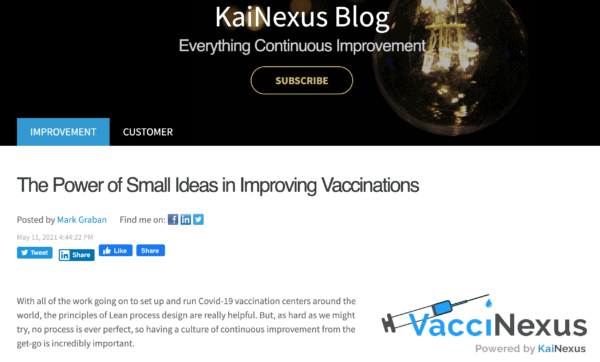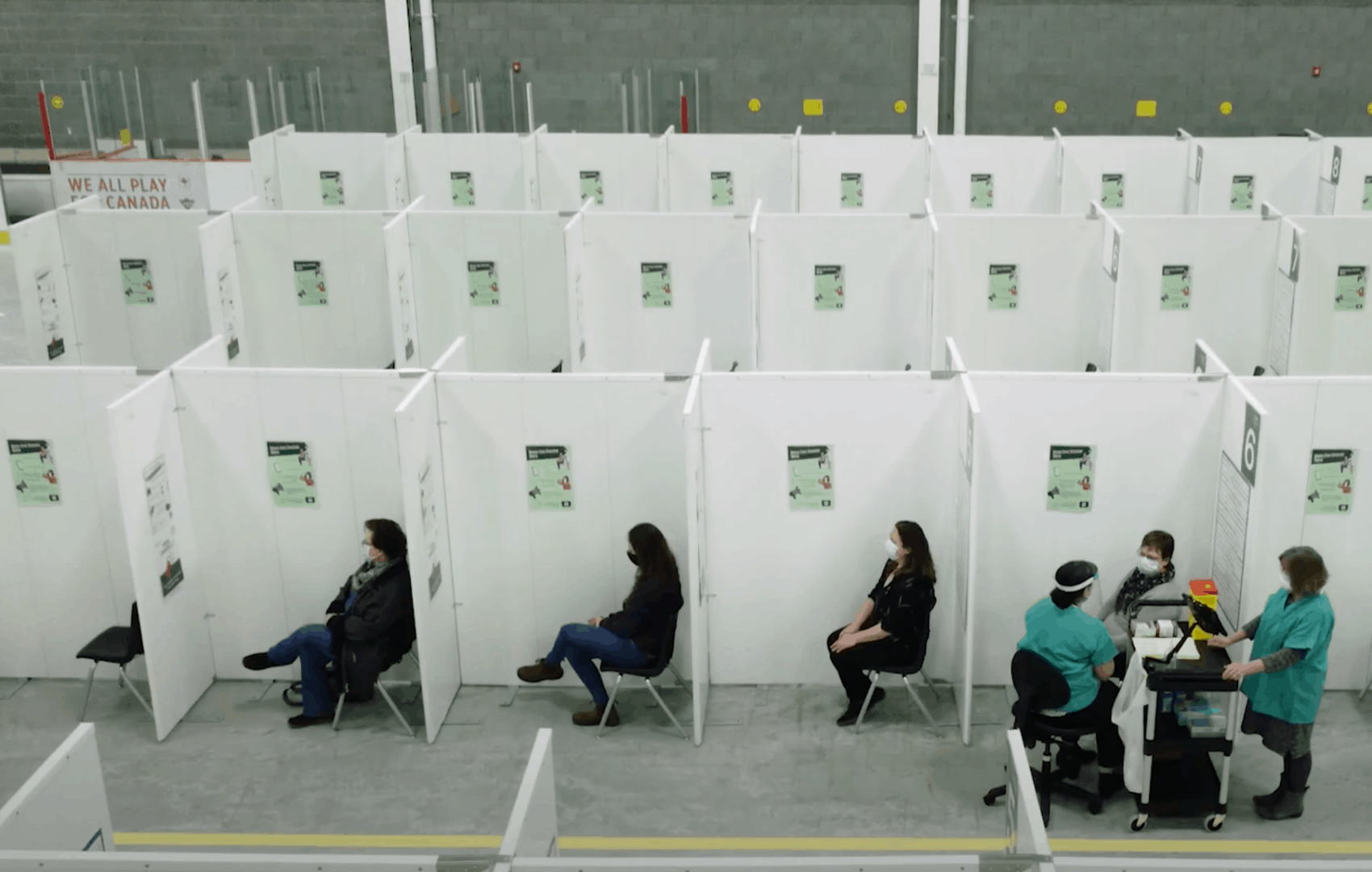In this era of Covid–19 vaccination, I'm still pretty much sidelined and not on site with any clients, although I did get to visit two mass vaccination sites (in addition to the one that vaccinated me).
I have tried really hard to be a cheerleader for continuous improvement and, in particular, for sharing continuous improvement ideas through the free VacciNexus platform and through other channels.
I believe, of course, in the power of many, many small improvements being driven by front line staff and their managers. That's the focus of my Healthcare Kaizen books. I also realize there's a time and a place for process re-design and for being innovative (thinking of it as step-change improvement.
Hear Mark read this post — subscribe to Lean Blog Audio
Small Improvements
On the topic of small improvements, I wrote a blog post recently for the KaiNexus continuous improvement blog:
The Power of Small Ideas in Improving Vaccinations

In the post, I've highlighted a few real examples of SMALL improvements that have been shared in the VacciNexus site.
I'm trying to encourage people to share more… especially the small things that might not seem worth sharing.
When people say, “I don't have any ideas,” they often mean, “I can't think of a million-dollar idea.” They assume (incorrectly) that a manager (or an outside consultant) only asks for big ideas with a substantial financial impact when we start a conversation about problems, ideas, or improvements.
At KaiNexus, we believe wholeheartedly in the power of small ideas making a big difference. You can watch a video (or read the transcript) here if you like. There's compelling research from Robinson and Schroeder that shows that, across industries, 80% of the total improvement potential in an organization comes from the accumulation of many small ideas.
I also reference this older podcast in the post:
Bigger Improvements
As a quick aside, please view a free webinar that was presented May 18th about a model that's step-change innovation… as the rest of this post will describe. The video of that can also be found below.
An Innovative “Patient First” Vaccination Clinic Design
From what I have seen first hand, and what I've heard from others, the vaccination process usually involves moving the patient from location to location as the work progresses. This is true with drive-thru sites and walk-through sites.

Sometimes registration is at a different location than vaccination, but there are usually three or four locations that the patient moves to.
A few months back, I heard about a very different model for setting up this process. It was referred to as the “hockey hub” model since it was done at a hockey rink. It's Canada, so hockey. But, the location wasn't the interesting thing. It was the process model that mattered — and that could be done at a football stadium, a golf course, or a non-sports-related location.
Here is a February press release from the town of Owen Sound, in Ontario:
Hockey Hub – COVID-19 Mass Immunization Hub in Grey Bruce
What's noteworthy about this model?
For one, the model is designed to be able to deliver “thousands of vaccines” per day, but it's also:
“… scalable in that it can be expanded or contracted depending on the amount of vaccine available and the number of clients to be vaccinated.”
When we have “cellular manufacturing” (in the context of Lean), that's a nicely scalable model. You can add more workers to the production “cells” or you can replicate (or staff up) cells to adjust volume in finer increments than you could with a traditional assembly line.
I've used the “cell” model to help redesign hospital laboratories, at least there's inspiration from that approach. The physical layout, and the staffing plan, can make a big difference in terms of quality, productivity, and flow.
But back to Grey Bruce…
The Hockey Hub uses a streamlined flow-through process. Once registered, the client remains in an individual pod for documentation, administering vaccine and recovery.
That “pod” is like a “cell.” In this case, the patient is stationary and the workers move to the patient.
The person administering the vaccine moves from pod to pod. The typical set-up in a standard rink would have 150 pods with one nurse assigned 30 pods each.
Here is a photo of the pods and a provider with cart, taken from this video, which is also embedded lower in this post:

There's also a focus, as we would have in the Lean mindset, on having clinical staff do ONLY the clinical work.
The efficiency of the Hockey Hub model is based on using clinical staff for clinical duties only and other staff for any task that is non-clinical.
I saw that same idea in action at the Frisco / Toyota vaccination site. At the vaccination table, there was a clinical person doing the vaccination and a non-clinical person doing data entry and other tasks. The Toyota site had the “patient moves from place to place” model.
The patient being stationary also reduces some risk:
There is a reduced risk of injury/fainting as clients are immunized and recover in the same location instead of risking fainting while walking to a recovery area (fainting is a well-known risk in immunization clinics).
The drive thru clinics I have seen have the vaccinated person (whether they are the driver or not) stay parked in the same place until their observation period is over.
I've heard of other drive thru sites that have the patient drive to an observation area, and they've expressed concerns about the safety risk of a driver fainting while moving even a small distance.
So, you have better safety… maybe it's a better experience for the patient, just being stationary, and Grey Bruce says it's more cost effective when you look at staffing efficiency:
A single vaccinator moving from pod-to-pod can administer 90 vaccines per hour.
A vaccinator at the Toyota / Frisco site could probably do 60 per hour with their process design.
They also say
“The model is cost-effective. The Hockey Hub costs about $6000 per thousand vaccines; about $1.7 million total for 140,000 population. Large volume clinics cost $26,000 per thousand or $7.2 million for 140,000 population.”
Having the provider moving from patient to patient (with a proper cart and other setup that provides good ergonomics), eliminates the provider waiting for the next patient to arrive. That waiting time is expensive and inefficient. Toyota solved that problem with the “on-deck chairs” that I blogged about before.
Here is a video about the Hockey Hub:
They intended that this model would spread throughout Ontario. It's also spreading across Canada.
Hockey Hub mass-vaccination model to help in Peel Region
“The model has expanded and with different evolutions across Canada,” Scongack said.
That's great to hear. Instead of just copying and pasting, it's even better when you can improve upon a model that was learned from others. You can copy the innovation and then apply continuous improvement to that model.
Manitoba adopting Grey-Bruce vaccination model
Manitoba will be modelling some of their “super” vaccination sites, after Grey-Bruce's “hockey-hub” model.
Modeling is better than just copying.
Inspired by this model, Dr. Joy Dobson, a former anesthesiologist in Regina, Sasketchewan has been creating a similar model that has just been put into use.
Joy also shared her model, the process for developing and refining the model, and their early results in a webinar:
Joy has been a weekly participant in a Zoom meeting that has been open to those who are using the VacciNexus site.
She first told us about the idea. Then, she showed us a “kitchen table simulation” of the model using parts of a cut-up cereal box. The mockups, learning, and trials continued from there.
I'm excited that she shared with us all in a more public way.
I hope you'll watch the recording — I think there important lessons here that might inspire improvement in other parts of healthcare, and beyond!
Please scroll down (or click) to post a comment. Connect with me on LinkedIn.
Let’s work together to build a culture of continuous improvement and psychological safety. If you're a leader looking to create lasting change—not just projects—I help organizations:
- Engage people at all levels in sustainable improvement
- Shift from fear of mistakes to learning from them
- Apply Lean thinking in practical, people-centered ways
Interested in coaching or a keynote talk? Let’s start a conversation.










Another “Hockey Hub” article:
Made-in-Canada solution: ‘Hockey hub’ vaccine clinics are getting the job done faster
Here is article that Toyota shared about helping with mass vaccination sites, including Frisco. There are also two embedded videos, one about Frisco and one about Dallas County efforts:
Toyota Supports COVID-19 Vaccine Administration